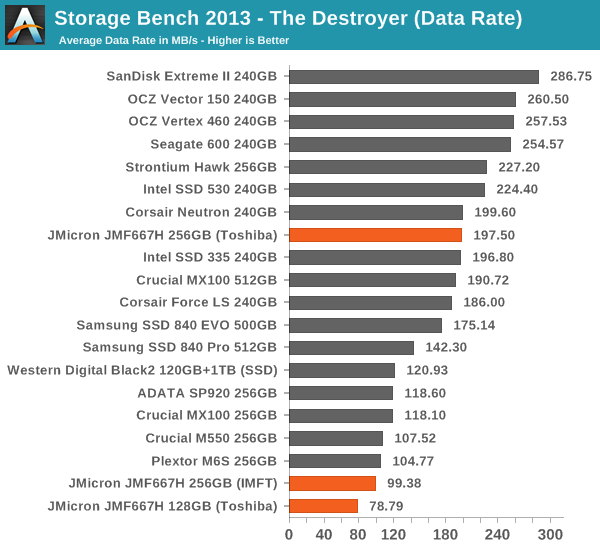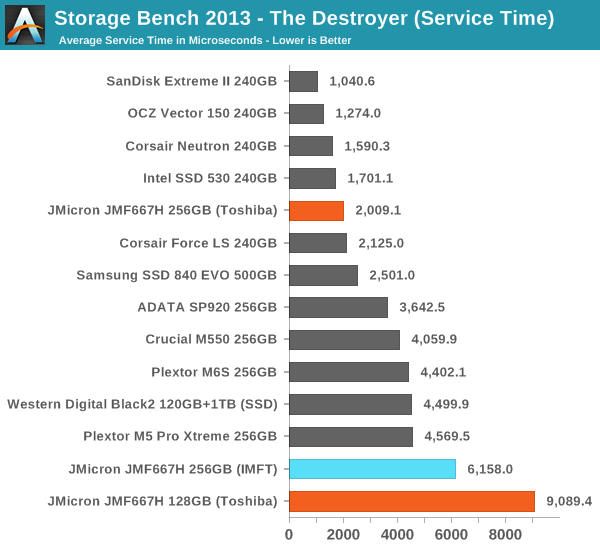JMicron JMF667H Reference Design (128GB & 256GB) Review
by Kristian Vättö on May 29, 2014 9:00 AM ESTAnandTech Storage Bench 2013
Our Storage Bench 2013 focuses on worst-case multitasking and IO consistency. Similar to our earlier Storage Benches, the test is still application trace based - we record all IO requests made to a test system and play them back on the drive we are testing and run statistical analysis on the drive's responses. There are 49.8 million IO operations in total with 1583.0GB of reads and 875.6GB of writes. I'm not including the full description of the test for better readability, so make sure to read our Storage Bench 2013 introduction for the full details.
| AnandTech Storage Bench 2013 - The Destroyer | ||
| Workload | Description | Applications Used |
| Photo Sync/Editing | Import images, edit, export | Adobe Photoshop CS6, Adobe Lightroom 4, Dropbox |
| Gaming | Download/install games, play games | Steam, Deus Ex, Skyrim, Starcraft 2, BioShock Infinite |
| Virtualization | Run/manage VM, use general apps inside VM | VirtualBox |
| General Productivity | Browse the web, manage local email, copy files, encrypt/decrypt files, backup system, download content, virus/malware scan | Chrome, IE10, Outlook, Windows 8, AxCrypt, uTorrent, AdAware |
| Video Playback | Copy and watch movies | Windows 8 |
| Application Development | Compile projects, check out code, download code samples | Visual Studio 2012 |
We are reporting two primary metrics with the Destroyer: average data rate in MB/s and average service time in microseconds. The former gives you an idea of the throughput of the drive during the time that it was running the test workload. This can be a very good indication of overall performance. What average data rate doesn't do a good job of is taking into account response time of very bursty (read: high queue depth) IO. By reporting average service time we heavily weigh latency for queued IOs. You'll note that this is a metric we have been reporting in our enterprise benchmarks for a while now. With the client tests maturing, the time was right for a little convergence.

While the JMF667H appears to be one of the slowest controllers we have tested, the situation isn't all that bad. 256GB Crucial M550 and Plextor M6S are only a few megabytes faster per second and bear in mind that these use more expensive 8-channel controllers from Marvell. When you look at it that way, the JMF667H is actually relatively competitive.
Unfortunately I did not have the time to process the trace of the 256GB drive with Toshiba NAND but I do have the service time for it, and it looks a lot better. Bear in mind that this drive is over-provisioned down to 240GB and thus can't be compared directly with the 256GB drive with IMFT NAND but compared to the other 240GB drives in the market, the JMF667H with Toshiba NAND certainly seems competitive.
Update 6/12: I was able to process the trace for the 240GB Toshiba drive and the performance is twice the IMFT version. It's a bit faster than the Phison-based Corsair Force LS, which is great news in terms of competition.











28 Comments
View All Comments
mflood - Thursday, May 29, 2014 - link
Looks like a great product for last year. This might help JMicron capture some of the OEM market - maybe even some budget enthusiast SSDs. What JMicron didn't do was swoop in with a M2 x4 PCIExpress controller. I'm done with 6Gbps SATA.romrunning - Thursday, May 29, 2014 - link
Ahhhh.... JMicron - like a phoenix from the ashes. Fool me once, shame on you. Fool me twice...Oh well, someone has to be at the bottom of the barrel.
romrunning - Thursday, May 29, 2014 - link
I guess their selling point would be that they're cheaper than the Crucial M500. So if pricing is all-important to you (and why are you buying a SSD if price is all-important), then they would be a contender.The_Assimilator - Thursday, May 29, 2014 - link
Please stop insulting barrels.moridinga - Thursday, May 29, 2014 - link
"The JMF667H is not perfect and there are a couple of things I would like to see. The first one is support for TCG Opal 2.0 and IEEE-1667 encryption standards."IEEE-1667 is not an encryption standard. Perhaps you meant IEEE-1619
Kristian Vättö - Thursday, May 29, 2014 - link
Nope. IEEE-1667 is for storage devices, at least the version I'm looking at.http://www.ieee1667.com/download/informational-doc...
moridinga - Friday, May 30, 2014 - link
Yes, it is authentication and discovery for storage devices (particularly removable/portable ones). It says nothing about encryption.Gigaplex - Saturday, May 31, 2014 - link
IEEE-1667 is a requirement for Microsofts Bitlocker eDrive, which is encryption.KAlmquist - Thursday, May 29, 2014 - link
Contrary to the history given in the introduction, it was with the the Indilinx "barefoot" controller that was the game changer. Once Indrilinx entered the market, SSD's based on the J-Micron controller could only be sold to consumers who didn't understand what they were buying. The name J-Micron became toxic because if you wanted to advise somebody on buying an SSD, your first and last words would be, "whatever you do, don't buy and SSD with a J-Micron controller."In contrast, Sandforce's first generation controller was an incremental improvement over what came before it. There's nothing wrong with that, but the term "game changer" doesn't apply.
HisDivineOrder - Thursday, May 29, 2014 - link
Seems like that early history explanation really misses the point that Indilinx was the first real competition to Intel back then.Sandforce came along and was the first company to put Intel down. But Indilinx was the first company that convinced people they could live with non-Intel SSD's and not... be JMicron'ed.